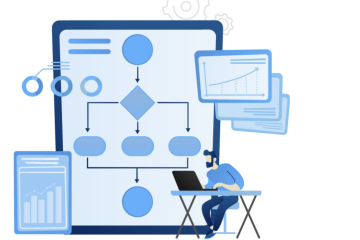
April 25, 2024
You have a contingency plan like most other intelligent businesses, but what if it fails? And, what happens when it’s too late?
Quick Links
Contingency plans can fail due to circumstances beyond our control, such as natural disasters, sudden market fluctuations, or changes in government policies, even due to internal matters like stakeholders not being properly trained.
The best solution is to make sure that any unusual activities are controlled beforehand. And, with SIEM you can do that effectively. SIEM helps businesses monitor data in real-time and mitigate any disruptions by automating threat response with the help of AI.
Origin of SIEM
Security information management (SIM) and security event management (SEM) come together to form SIEM.
Most people often get confused with security information management and security event management, and they are often used interchangeably for assessing security-related events. But they do carry certain differences:
- SIM is a long-term, broader software used for collecting, storing, and monitoring event and activity log data for analysis.
- SEM is a real-time software used for monitoring and analyzing security events and alerts to identify patterns and respond to incidents.
SIM and SEM helped with tracking and logging of data for compliance purposes. And, to get the best of both worlds, Gartner coined the term SIEM in 2005.
How Does SIEM Work?
SIEM tools help you to collect, and analyze data from your devices, applications, servers, and users in real time. The data is collected from a number of sources like host systems, security devices, antivirus filters, and firewalls. Then, the data is then stored centrally and then analyzed to find any unusual activity. SIEM tools rely on pre-defined rules to help your security teams spot any threats and alert you before things go haywire.
With SIEM tools, you can find and sort out any potential threats as well, such as malware, ransomware, phishing, denial-of-service, and insider attacks. They can also create alerts, reports, and dashboards to help your teams monitor and respond to any spikes. You can get an overall view of your organization’s security status by centralizing and correlating this information with SIEM tools.
SIEM tools serve three main purposes:
- Improved network visibility
- Automation to improve cybersecurity
- Reporting to support compliance and forensic investigations
The Execution of SIEM Solutions
Establish Requirements – Before applying a SIEM solution, it’s important that you identify what are your organization’s security and compliance needs. This involves:
Regulatory system: Security teams must research about the relevant regulations specific to your industry and internal policies that dictate your organization’s security and compliance requirements.
Data sources: Identify all data sources to be monitored, such as firewalls, intrusion detection systems, endpoint security tools, authentication systems, and application logs. After this, sort them based on their criticality and risk levels.
Desired outcomes: Clearly articulate the goals of implementing an SIEM solution, such as reducing incident response time, ensuring compliance with specific regulations, or use case priorities such as gaining insights into user behavior.
Implementation Planning – The detailed implementation plan should be developed once the requirements have been determined. The following areas should be covered by this plan:
SIEM selection: Review different SIEM solutions that exist in the market, such as functionality, scalability, ease of use, integration capabilities, and cost. For a more informed choice, one might think of conducting a proof-of-concept.
Project scope and timeline: Explain what the SIEM implementation project will entail including data sources to consider and also necessary integrations. Set realistic milestones for each step of this journey.
Stakeholder involvement: Enable collaboration, communication, and goal alignment by engaging with key stakeholders from IT, security, and compliance team members. Specific roles must be assigned to each team member.
Training plan: Create a training program that can impart skills related to effective utilization and management of the SIEM system among team members. This shall range from administration of systems, dealing with incidents or reports plus solving problems.
Deployment and Review – The deployment phase includes steps such as installing, configuring, and integrating the SIEM solution with your organization’s IT infrastructure:
SIEM installation: Start by setting up the SIEM solution by installing the required software or hardware, as well as necessary agents or connectors on the relevant devices.
Configuration: Next, define the data normalization and correlation rules to make sure that events from different sources are correctly analyzed and correlated. You need to create custom rules, alerts, and dashboards best suited to your organization’s needs.
Security policies and workflows: After this, develop and implement security policies to decide how the SIEM system would be used. It is a must to set up response workflows for handling alerts and incidents, including escalation procedures and communication channels.
Testing: Testing is mandatory – how else would you be sure what you worked for actually works! In the next steps, you need to carry out an in-depth testing of the SIEM system to test its functions, effectiveness, and accuracy in finding threats, creating alerts, and providing context for incident response.
Review and refinement: The final step is to gather feedback from stakeholders and end-users to identify areas for improvement. For this, you need to refine the system configuration, rules, and alerts to address any gaps or issues discovered during the testing and review phase.
Post-Implementation – Some of these activities include:
Policy and rule changes: Revise and update security policies, rules, and alerts as part of reviewing them frequently to make sure that they remain current and useful even with new kinds of threats being posed by emerging business needs.
Optimizing performance: Observe the implementation of resources in the SIEM system closely. Adjustments are essential to optimize the utilization of resources.
Threat intelligence: Get information on the latest trends in security risks, vulnerabilities, and threats by including external threat intelligence feeds into the SIEM solution.
Continuous training & support: Continuously train, document, and assist team members with managing and using the SIEM system effectively.
Periodic reviews and audits: Carry out periodic reviews and audits to determine if an SIEM system is effective or not and whether it complies with the organization’s security needs or not. The findings from these will guide data-driven decisions aiming at further optimizing and improving management.
Benefits of SIEM
There are a variety of benefits to running a SIEM solution:
Advanced Visibility – Aggregating all of your logs across your on-premises and cloud-based applications, servers, databases, and more to gain deeper insights enables you to maintain oversight into your network and beyond the perimeter as your company scales.
Data Normalization – All of the different technologies across your environment generate a ton of data in many different formats. While not every SIEM solution will collect, parse, and normalize your data automatically, many do offer ongoing parsing to support multiple data types.
Log Correlation – In addition to collecting logs, an SIEM can correlate them for analysis. This enables the creation of security alerts, trends, and reports. An organization can correlate events like suspicious DNS activity; unusual port activity on routers and firewalls; endpoint or antivirus threats; etc. to detect a potential attack.
Threat Detection – Correlation and analysis lead to threat detection and alerting. Once an SIEM is properly configured and tuned to fit your environment, you can surface indicators of a compromise or threats that can lead to a breach. It’s important to find the right balance of false positives and false negatives to reduce the noise of alerts that impact your team so they know when to take action for remediation.
Help Meet Compliance – Many compliance regulations spanning different industries require organizations to collect and keep a history of audit logs for a certain time, detect and respond to threats, as well as produce regular security reports for auditors.
The Future
Like many business costs, security is an investment that brings additional value over time. While many security solutions may become obsolete, SIEM will become more stable and add more value to businesses.
SIEM isn’t a one-size-fits-all automated solution that can eliminate all cybersecurity risks, it is an important part of many businesses’ security systems. Your SIEM solution is more than just a cash outlay. Automating systems in a way that streamlines procedures and improves your overall security posture for the future necessitates a company-wide investment of time and money.
Author’s Bio:
With our best infotech publication, Cienteinfotech, business leaders stay abreast of tech news and market insights that help them level up now.
Technology spending is increasing, but so is buyer’s remorse. We are here to change that. Founded on truth, accuracy, and tech prowess, Ciente is your go-to periodical for effective decision-making.
Our comprehensive editorial coverage, market analysis, and tech insights empower you to make smarter decisions to fuel growth and innovation across your enterprise.
Let us help you navigate the rapidly evolving world of technology and turn it to your advantage.





